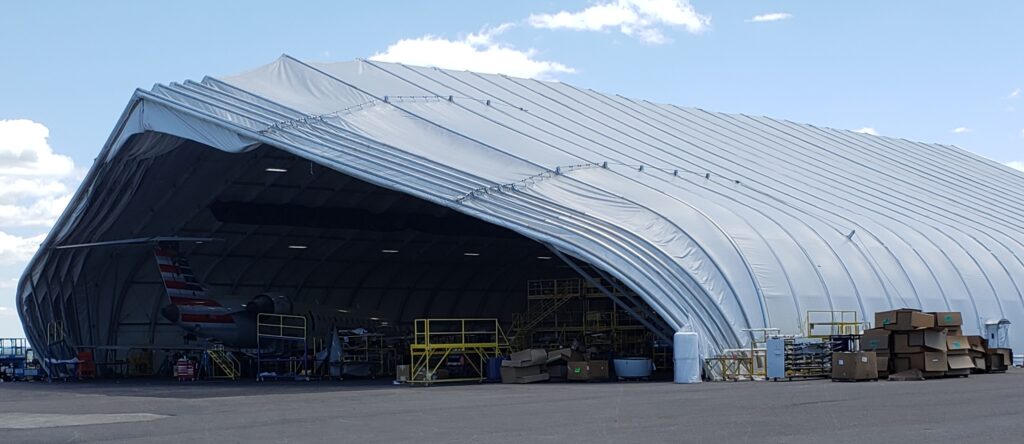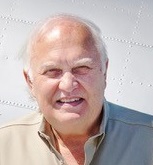Leeham News and Analysis
There's more to real news than a news release.
Leeham News and Analysis
Pontifications: MHIRJ prepares for narrowbody aftermarket business
June 21, 2021, © Leeham News: MHIRJ Aviation Group said last week its 100,000 sf expansion of MRO facilities is sized to accommodate narrowbody aircraft.
MHIRJ is the former Bombardier CRJ global product support system purchased last year by Mitsubishi Heavy Industries.
The expansion, valued at $20m, was first disclosed by LNA in its May 31-June 1 one-year anniversary updates.
Related stories:
- Mitsubishi grows ex-Bombardier business: One Year later, Part 1
- MHIRJ expanding floor space: One Year later, Part 2
Ismail Mokabel, Senior Vice President, Head of Aftermarket, told LNA then that MHIRJ would be ready to diversify its aftermarket work beyond the CRJ regional jet after 2023. In a groundbreaking ceremony of the hangar expansion at its Bridgeport (WV) facility June 16, Mokabel disclosed that hangars will be big enough for narrowbody jets.
Watch what MHI does
Several months ago, LNA was told to watch what MHIRJ’s parent, MHI, does with the aftermarket business. MHI bought the CRJ program and its global product support system to lay the foundation for the Mitsubishi SpaceJet program. But shortly before closing the CRJ deal June 1 last year, MHI “suspended” development of the SpaceJet. Since then, MHI defunded the program by 99%. Although officials haven’t officially killed the SpaceJet, the program is considered dead.
This raised questions about the future of MHIRJ. The $20m investment to add 100,000 sf at the Bridgeport facility is a dramatic turnaround since the Bombardier ownership.
Airport, state political figures and Bombardier’s own CRJ people worked for a decade to win corporate funding for expansion. Bombardier’s own weak balance sheet and three simultaneous new airplane development programs nearly drove the company into bankruptcy.
MHI stepped up and committed to grow its new acquisition.
Temporary expansion

MHIRJ Aviation Group erected a big tent as temporary expansion at the Bridgeport (WV) airport. The tent will help serve as an interim MRO facility until 100,000 sf of new hangar space is built. Photo: Leeham News.
Mokabel said last week that MHIRJ expanded at Bridgeport by erecting a giant tent to service CRJs. The hangar and certification for heavy maintenance was approved by the Federal Aviation Administration in three months. Other tents already exist.
When the 100,000 sf of hangar space is added, MHIRJ will have 341,000 sf of hangar space at Bridgeport. Employment will increase by 300 workers. MHIRJ currently wants to add 150 jobs.
MHIRJ and the airport currently employ 2,345 people of the 10,729 across the state in the aviation industry. MHIRJ and the airport account for $775m of the statewide $1.63bn in aerospace revenues.
Share this:
- Click to print (Opens in new window) Print
- Click to email a link to a friend (Opens in new window) Email
- Click to share on X (Opens in new window) X
- Click to share on Pinterest (Opens in new window) Pinterest
- Click to share on Facebook (Opens in new window) Facebook
- Click to share on WhatsApp (Opens in new window) WhatsApp
- Click to share on LinkedIn (Opens in new window) LinkedIn
- Click to share on Tumblr (Opens in new window) Tumblr
- Click to share on Reddit (Opens in new window) Reddit
Related
Category: Mitsubishi, Pontifications
Tags: Bombardier, CRJ, MHIRJ Aviation Group


99% defunded ? I thought it was still in the $100 mill league. Don’t forget theirs a final assembly line at Mitsubishi Aero engines for the PW1200G , they are a partner with P&W on the whole GTF project. There’s the completed new Spacejet assembly building etc. Getting real news out of Japan is difficult as the media works a club system, often merely mouthpieces for the company. So I can’t see Mitac walking away now in what is a government supported prestige project.
@Duke: The 1200G is only for the SpaceJet and the E175-E2. Neither jet is in production. So the engine isn’t, either. The contract with P&W has been revised to reflect the SpaceJet status. SpaceJet is dead.
Interestingly the recently announced Falcon 10X business jet is pretty much exactly the dimensions of the 76 seat SpaceJet M100:
* Cabin of 10X is one cm higher and wider than that of the M100
* The overall length of the 10X is 90cm less than the M100
* The 10X cabin is 16.4m long (excluding flight deck and baggage area) with 19 windows a side (19 rows at 31″ is 15m).
* Low pressure altitude and large windows
* Designed for short runways and steep approaches
* Cockpit layout is the latest with an eye to future single pilot operations
* Unlike the M100 it is low to the ground and can easily operate without ramps.
* High aspect ratio efficient wing
* Fast cruise of Mach .85, .925 max.
Some quick first order calculation:
According to Desault the range with 8 passengers and 4 crew is 7,500nm at Mach .85. Presumably that is with a full fuel load of 51,700lb.
Going to 76 passengers adds 68*212 = 14,416lb. Yes there will be more seats but there will also be a lot less luxury equipment so assume that will be a wash. This means max fuel would be about 72% of the 8 passenger weights. If range falls in proportion that will mean a range of 5,400nm.
The high cruise speed means it would be able to a perform daily out and back flights to about 5000nm allowing for 2 hour turn-around at each end.
If Dassault wanted to market a small passenger jet for thin long distance routes they have the right airframe to start from.
Unfortunately with a MTW of 115,000 it is hard to see how it could be made to be US scope clause compliant for use on US regional routes. But then it is probably not built for high cycles anyway.
Special business jets are only designed for say 500-700 hrs per year, fatigue life is maybe 15,000 hrs etc, their engines are similar. The large capacity jets have wings optimised for high altitude and fast long range cruise. Short haul is out of the question really. Bombardier made a lot of changes to its fuselage wings engines and systems to create the CRJ line
I wouldn’t count Dassault out, smart people though now government owned.
Someday there may be a need to replace RJs, of course Embraer wants that work. (And not to forget that Brazil and Japan have had ties for a very long time.)
After all, that is how the A220 began – a wide cabin business jet collaboration of Bill Lear and Bombardier family, that expanded into the RJ (which smartly fit a need in the airline industry), then lept into under-wing larger airliners.
I read that Dassault is still independent, 10% owned by Airbus.
Bombardier and Gulfstream continue to advance their product lines.
The wide body business jet from Bill Lear was developed by Canadair as Challenger line not Bombardier family. It was the scions of the family as CEO who promoted the CRJ as a next step up and then Cseries as a follow on, as well as the Global Express large BJ and medium jet above and below the Challengers.
Dassault isnt government owned , and its quite a conglomerate now with its CAD/CAM subsidiary and international services (non aviation) business Veolia. Their track record shows they stick to their core businesses in aviation and invest in non aviation areas
Groupe Industriel Marcel Dassault , the family investment vehicle has some say 60% plus depending on whether its just shares or voting shares. Airbus is under 10%.
The very last thing they would do was a regional jet.
> SpaceJet is dead.
What this primarily a political rather than economic decision? Looks that way, at first
glance.
OTOH there is a need for a 757 replacement.
[Japan has wanted to build airliners.
YS-11 only middling success, albeit in an era where old iron was still viable.
Has a nice turboprop flying boat that might replace the Martin Mars, versions with or without regular wheels, efficiency I don’t know.
Builds major chunks of Boeing airplanes.
Canada is a lower cost place to manufacture than the US, will be for several years IMO but MHI would need much more distant horizon.]
Any thoughts on why MHI would want to play in this space?
It made sense if the Spacejet continued but clearly its not.
Its small potatoes and huge amount of competition for what gain?
“According to a presentation Monday [May 2021] outlining the industrial giant’s fiscal year 2020 earnings (ending March 31) and fiscal year 2021 strategy, Mitsubishi said it will “continue type certification documentation and assess possible program restart” for the SpaceJet in 2021.”
I wonder what other manufacturers have ‘paused’ development programs in 2020- I can think of a few .
Per Scott, Spacejet is dead. It never made any sense to start with (wishful thinking on the scope), Embraer cant even sell the E175 E2. Its not just a pause for the market reasons. Its a pause because it never made any sense.
It looks like 2024 at best and the program is on hold.
Cost difference between MHI and Embraer is not going to be close.
MHI has the contract for the F-X jet fighter and that is fully in line with their cost structure (ie government program that is directed at sustaining a mfg base vs the costs – aka Lockheed of Japan)
Embraer can’t sell the E175-E2 – why ?
Others programs were paused -why?
Answers to those questions refute your claims.
Here’s another
Mitsubishi says it could restart SJ for what reason.
They have their first plane originally the MRJ90 on the final stretch and that will be unpaused first.
Confidence is a powerful driver in aviation as it results in passengers flying, airlines opening new routes and buying planes and all of these is what manufacturers need.
Sure Mitsubishi is a fast jet specialist who had never done a commercial airliner, so was a high risk who unfortunately didn’t take the obvious option of partnering with Bombardier who they were a risk sharer on the Global Express (surprinsly similar in size to MRJ). However the other Japanese airframers are sub contractors and they are involved in the GTF engine version as well. I feel that some views here are of a short term ‘wall street’ outlook which isn’t how it’s done in Japan